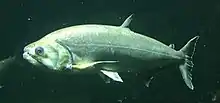Hydrolycus armatus
Hydrolycus armatus is a species of dogtooth characin found in freshwater of tropical South America.[1] It is sometimes known as the payara,[2][3][4] a name it shares with the related H. scomberoides.
| Hydrolycus armatus | |
|---|---|
 | |
| Adult in Berlin Aquarium, Germany | |
Not evaluated (IUCN 3.1) | |
| Scientific classification | |
| Kingdom: | Animalia |
| Phylum: | Chordata |
| Class: | Actinopterygii |
| Order: | Characiformes |
| Family: | Cynodontidae |
| Genus: | Hydrolycus |
| Species: | H. armatus |
| Binomial name | |
| Hydrolycus armatus (Jardine, 1841) | |
This predatory fish occasionally makes its way into the aquarium trade, but it requires a very large tank.[2][5] In its native range it is considered a major gamefish.[4][5]
Distribution and habitat
This species of fish is found in the Amazon, Orinoco and Essequibo basins in tropical South America.[1][6] They are found in several different freshwater habitats, but often in fast-flowing water.[4][7] They are typically found in deeper waters during the day.[7] The species is locally common; in a major study of a Venezuelan floodplain river, 1⁄3 of the collected fish were H. armatus, and the species was particularly common in creeks and lagoons.[8] At least some populations are migratory.[7]
Description
H. armatus are overall silvery. In adults the base of the tail and anal fin is pale yellowish, and the distal part is blackish, contrasting with a narrow white edge at the very tip (unique among Hydrolycus species).[2][6][9]
A typically reported maximum total length of this fish is 89 cm (2.92 ft),[1] but records show specimens up to 95 cm (3.12 ft) in Venezuela[3] and more than 100 cm (3.3 ft) in Brazil.[4] It typically weighs up to 8.5 kg (19 lb),[1] but can reach almost 18 kg (40 lb).[4] It has frequently been confused with the generally smaller H. scomberoides.[2][6] H. armatus reaches maturity when at least 30 cm (1 ft) long.[7] Like other dogtooth characins, it has very long pointed canine teeth. In H. armatus these can surpass 5 cm (2 in) in length in large individuals.[3] These are used for spearing their prey, usually other fish.[9]
References
- Froese, Rainer and Pauly, Daniel, eds. (2017). "Hydrolycus armatus" in FishBase. January 2017 version.
- SeriouslyFish: Hydrolycus armatus. Retrieved 13 January 2017.
- OPEFE: Payara Venezuela. Retrieved 13 January 2017.
- "Payara—Hydrolycus armatus". Acute Angling. Retrieved 19 October 2017.
- Scott, B.M. (March 2007). "Taming the Untamable—Giant Payara!". TFH Magazine. Retrieved 19 October 2017.
- Toledo-Piza, M.; N.A. Menezes; G.M. Santos (1999). "Revision of the Neotropical fish genus Hydrolycus (Ostariophysi: Characiformes: Cynodontidae) with the description of two new species". Ichthyol. Explor. Freshwaters. 10 (3): 255–280.
- van der Sleen, P.; J.S. Albert, eds. (2017). Field Guide to the Fishes of the Amazon, Orinoco, and Guianas. Princeton University Press. p. 155. ISBN 978-0691170749.
- Layman, C.A..; K.O. Winemiller (2005). "Patterns of habitat segregation among large fishes in a Venezuelan floodplain river". Neotrop. Ichthyol. 3 (1): 111–117. doi:10.1590/S1679-62252005000100007.
- "Subfamily Cynodontinae". OPEFE. Retrieved 19 October 2017.
